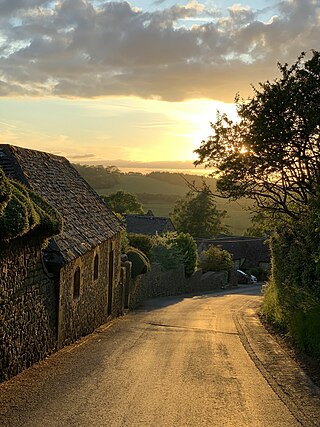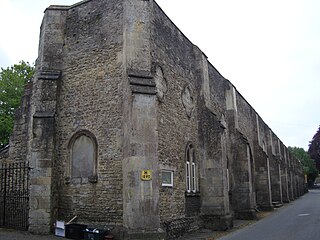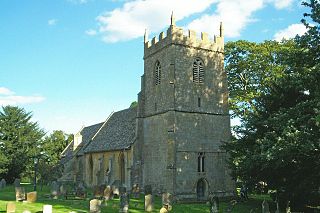
Ascott House, sometimes referred to as simply Ascott, is a Grade II* listed building in the hamlet of Ascott near Wing in Buckinghamshire, England. It is set in a 32-acre / 13 hectare estate.

Bucklebury is a village and civil parish in West Berkshire, England, about 5 miles (8 km) north-east of Newbury and 1–3 miles (1.6–4.8 km) north of the A4 road. The parish has a population of 2,116, but the village is much smaller. Bucklebury Common, with an area of over 1 square kilometre (0.39 sq mi), is one of the largest commons in the ceremonial and historic county of Berkshire.

West Drayton is a suburban town in the London Borough of Hillingdon. It was an ancient parish in the county of Middlesex and from 1929 was part of the Yiewsley and West Drayton Urban District, which became part of Greater London in 1965. The settlement is near the Colne Valley Regional Park and its centre lies 1.9 miles (3 km) north of Heathrow Airport.

Broadway is a large village and civil parish in the Cotswolds, England, with a population of 2,540 at the 2011 census. It is in the far southeast of Worcestershire, close to the Gloucestershire border, midway between Evesham and Moreton-in-Marsh. It is sometimes referred to as the "Jewel of the Cotswolds".

Charles Paget Wade was an English architect, artist-craftsman and poet of Afro-Caribbean descent; today he is perhaps best remembered for the eclectic collection he amassed during his life, a collection which can be seen at Snowshill Manor, his former home in the village of Snowshill, Gloucestershire, which he gave to the National Trust in 1951.

Snowshill is a small Cotswolds village and civil parish in Gloucestershire, England, located near Broadway, Worcestershire. The population taken at the 2011 census was 164.

Winchcombe Abbey is a now-vanished Benedictine abbey in Winchcombe, Gloucestershire; this abbey was once in the heart of Mercia, an Anglo Saxon kingdom at the time of the Heptarchy in England. The Abbey was founded c. 798 for three hundred Benedictine monks, by King Offa of Mercia or King Coenwulf of Mercia. In its time, it was the burial place of two members of the Mercian ruling class, the aforementioned Coenwulf and his son Cynehelm, later venerated as Saint Kenelm.

Avebury Manor & Garden is a National Trust property consisting of a Grade I listed early-16th-century manor house and its surrounding garden. It is in Avebury, near Marlborough, Wiltshire, England, in the centre of the village next to St James's Church and close to the Avebury neolithic henge monument.

Bledington is a village and civil parish in the Cotswold district of Gloucestershire, England, about four miles southeast of Stow-on-the-Wold and six miles southwest of Chipping Norton. The population of the civil parish in 2014 was estimated to be 490.

Buckland is a village and civil parish in the borough of Tewkesbury, Gloucestershire, England. The parish, which also includes the village of Laverton, had a population of 225 in 2010. The village is close to the Worcestershire border and 1.2 miles (2 km) south of Broadway. East of the village is the Burhill Iron Age hillfort. To the south, and within Buckland Parish, is the hamlet of Laverton. Within the village itself is the medieval Church of St Michael, a seventeenth-century manor house, and what claims to be the oldest Rectory in England.

Berrington Hall is a country house located about 3 miles (5 km) north of Leominster, Herefordshire, England. During the 20th century it was the seat of the Cawley family.

Kinwarton is a village in the valley of the River Alne, Warwickshire, to the north-east of the market town of Alcester. The population of the civil parish at the 2011 Census was 1,082. The ground is mostly low-lying, with a maximum altitude of 206 ft. and some of the fields near the river are liable to floods. The road from Alcester to Henley-in-Arden runs through the middle of the parish. A branch road leads off to the church and rectory about a quarter of a mile to the south and thence continues as a field-path down to a ford across the River Alne below Hoo Mill. From the north side of the main road a by-road branches off to Coughton.

Hellens Manor,, is a historic house located in the village of Much Marcle in Herefordshire, England. It is one of the oldest dwellings in England, being composed primarily of Tudor, Jacobean and Georgian architecture but with foundations dating from the 12th century.

Bruton Abbey in Bruton, Somerset was founded as a house of Augustinian canons in about 1127, and became an abbey in 1511, shortly before its dissolution in 1539. It was endowed with manors, churches and other properties in the area and also in Normandy in France.

Lytes Cary is a manor house with associated chapel and gardens near Charlton Mackrell and Somerton in Somerset, England. The property, owned by the National Trust, has parts dating to the 14th century, with other sections dating to the 15th, 16th, 18th, and 20th centuries. "Yet all parts blend to perfection with one another and with the gentle sunny landscape that surrounds them," comments Nikolaus Pevsner. The House is listed as Grade I by English Heritage.

Ebrington is a village and civil parish in Gloucestershire, England, about 2 miles (3.2 km) from Chipping Campden. It has narrow lanes and tiny streets of Cotswold stone houses and cottages, many of which are thatched.

Hidcote Bartrim is a hamlet and former civil parish, now in the parish of Ebrington, in the Cotswold district of Gloucestershire, England. The nearest town is Chipping Campden, which is approximately 2.75 miles (4.43 km) south-west from the village. The village is on the Gloucestershire-Warwickshire border. It should not be confused with Hidcote Boyce, a similarly sized village roughly 0.5 miles (0.8 km) south of Hidcote Bartrim. In 1931 the parish had a population of 47.

Mottistone Manor is a National Trust property in the village of Mottistone on the Isle of Wight, England. It has popular gardens and is a listed building. It was first mentioned in documents related to the Domesday Book of 1086.

Frampton Court is a Grade I listed country house and estate of about 1,500 acres (610 ha) in Frampton-on-Severn, Gloucestershire, England. It has been owned by the Clifford family since the 11th century. The main buildings are the 18th century Frampton Court and, on the opposite side of the village green, Manor Farm. The gardens at Frampton Court have a Gothic orangery and ornamental canal in the style of William Halfpenny. The two houses, barn and orangery are all Grade I listed buildings in their own right, while the Gatepiers and Gates are Grade II* listed.



















